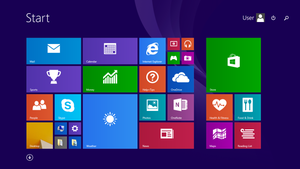Download And Install Windows 8.1 Pro Disc Image (ISO) Gdrive
Download And Install Windows 8.1 Pro Disc Image (ISO) Gdrive
About Windows 8.1
| A version of the Windows NT operating system | |
 Default Windows 8.1 start screen. | |
| Developer | Microsoft |
|---|---|
| OS family | Microsoft Windows |
| Source model | |
| Released to manufacturing | August 27, 2013[1] |
| General availability | October 17, 2013[2] |
| Latest release | 6.3.9600 / April 8, 2014[3] |
| Update method | Windows Update, Windows Store, Windows Server Update Services |
| Platforms | IA-32, x64 |
| Kernel type | Hybrid |
| License | Trialware, Microsoft Software Assurance, MSDN subscription, Microsoft Imagine |
| Preceded by | Windows 8 (2012) |
| Succeeded by | Windows 10 (2015) |
| Official website | www |
| Support status | |
All editions except Windows Embedded 8.1 Industry:
Windows Embedded 8.1 Industry: | |
Windows 8.1 is an operating system that was produced by Microsoft and released as part of the Windows NT family of operating systems. It was released to manufacturing on August 27, 2013, and broadly released for retail sale on October 17, 2013, about a year after the retail release of its predecessor. Windows 8.1 was made available for download via MSDN and Technet and available as a free upgrade for retail copies of Windows 8 and Windows RT users via the Windows Store. It was succeeded by Windows 10 in July 2015. A server counterpart was released on October 18, 2013, entitled Windows Server 2012 R2. Microsoft ended mainstream support for Windows 8.1 on January 9, 2018, and extended support will have ended by January 10, 2023.
Windows 8.1 aimed to address complaints of Windows 8 users and reviewers on launch. Visible enhancements include an improved Start screen, additional snap views, additional bundled apps, tighter OneDrive (formerly SkyDrive) integration, Internet Explorer 11 (IE11), a Bing-powered unified search system, restoration of a visible Start button on the taskbar, and the ability to restore the previous behavior of opening the user's desktop on login instead of the Start screen. IE11 is also shipped with Windows 10 on its release on July 29, 2015, but Microsoft Edge is the default browser in this version of Windows. Windows 8.1 also added support for such emerging technologies as high-resolution displays, 3D printing, Wi-Fi Direct, and Miracast streaming, as well as the ReFS file system.[6] After January 12, 2016, Microsoft announced that they'll be moving Windows 8 to Windows 8.1 or Windows 10 for continued support.
Windows 8.1 received more positive reception than Windows 8, with critics praising the expanded functionality available to apps in comparison to Windows 8, its OneDrive integration, along with its user interface tweaks and the addition of expanded tutorials for operating the Windows 8 interface. Despite these improvements, Windows 8.1 was still criticized for not addressing all digressions of Windows 8 (such as a poor level of integration between Metro-style apps and the desktop interface), and the potential privacy implications of the expanded use of online services. As of August 2020, 4.5% of traditional PCs running Windows are running Windows 8.1.[7] IE11 was made available for Windows Server 2012 and Windows Embedded 8 Standard in April 2019.[8] Microsoft supports the new Microsoft Edge web browser on Windows 8.1 since January 31, 2020.[9]
Note: Comment for bad links and how to install without errors
DOWNLOAD LINKS

Comments
Post a Comment